In the design of PCB boards, with the rapid increase in frequency, many interferences different from the design of low-frequency PCB boards will appear. Moreover, as the frequency increases, the contradiction between the miniaturization and low cost of PCB boards has become increasingly prominent. These disturbances are becoming more and more complex. In the actual research, we sum up, there are four main interferences, including power supply noise, transmission line interference, coupling, and electromagnetic interference (EMI). Through analyzing various interference problems of high-frequency PCB, combined with practice in work, an effective solution is proposed.
1. Power supply noise
In the high-frequency circuit, the noise of the power supply has a particularly obvious influence on the high-frequency signal. Therefore, the first requirement is that the power supply is low-noise. Here, a clean ground is as important as a clean power source. Why? The power characteristic is shown as in Fig. 1. Obviously, the power supply has a certain impedance, and the impedance is distributed on the entire power supply, so noise will also be superimposed on the power supply. Then we should reduce the impedance of the power supply as much as possible, so it is best to have a dedicated power layer and ground layer. In high-frequency circuit design, the power supply is designed in the form of layers, and in most cases it is much better than the design in the form of a bus, so that the loop can always follow the path with the least impedance. In addition, the power board has to provide a signal loop for all generated and received signals on the PCB, so that the signal loop can be minimized, thereby reducing noise, which is often overlooked by low-frequency circuit designers.
Figure 1 Power supply characteristics
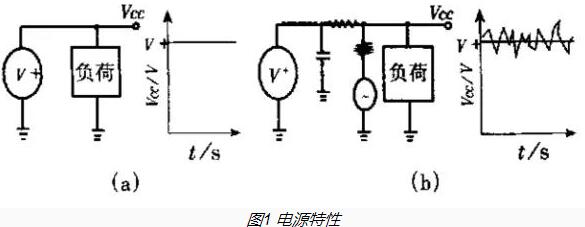
There are several ways to eliminate power supply noise in PCB design.
1. Pay attention to the through holes on the board: the through holes make the power layer need to etch openings to leave space for the through holes to pass through. If the opening of the power layer is too large, it will inevitably affect the signal loop, the signal is forced to bypass, the loop area increases, and the noise increases. At the same time, if some signal lines are concentrated near the opening and share this loop, the common impedance will cause crosstalk. as shown in picture 2.
Figure 2 Common path of bypass signal circuit
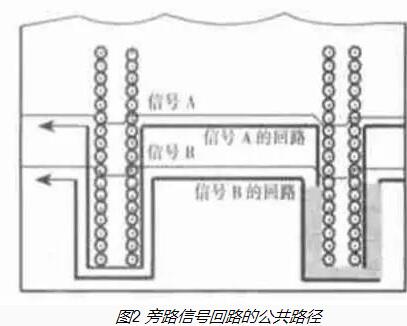
2. Connecting wires need enough ground wires: each signal needs to have its own proprietary signal loop, and the loop area of the signal and loop should be as small as possible, that is to say, the signal and the loop should be parallel.
3. The power supply of analog and digital power supply should be separated: high-frequency devices are generally very sensitive to digital noise, so the two should be separated and connected together at the entrance of the power supply. If the signal needs to cross the analog and digital parts, it can be Place a loop at the crossing to reduce the loop area. The crossover between digital and analog used in the signal loop is shown in Figure 3.
Figure 3 Crossover between digital and analog for signal loop
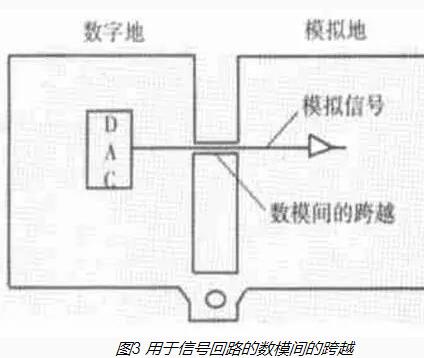
4. Avoid overlapping of separate power supplies between different layers: otherwise circuit noise is easily coupled through parasitic capacitance.
5. Isolate sensitive components: such as PLL.
6. Place the power line: In order to reduce the signal loop, reduce the noise by placing the power line on the edge of the signal line, as shown in Figure 4.
Figure 4 Place the power line on the edge of the signal line
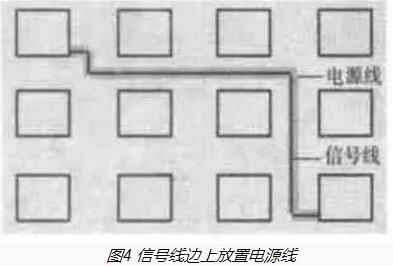
2, the transmission line
There are only two possible transmission lines in PCB: strip line and microwave line. The biggest problem of transmission line is reflection. Reflection will cause many problems. For example, the load signal will be the superposition of the original signal and the echo signal, which increases the difficulty of signal analysis. ; Reflection will cause return loss (return loss), and its impact on the signal is as serious as the impact of additive noise interference:
1. The signal reflected back to the signal source will increase the system noise, making it more difficult for the receiver to distinguish the noise from the signal;
2. Any reflected signal will basically degrade the signal quality and change the shape of the input signal. In principle, the solution is mainly impedance matching (for example, the interconnection impedance should match the impedance of the system very well), but sometimes the impedance calculation is more troublesome, you can refer to some transmission line impedance calculation software.
The method to eliminate transmission line interference in PCB design is as follows:
(A) Avoid discontinuities in the impedance of the transmission line. The point where the impedance is discontinuous is the point where the transmission line has abrupt changes, such as straight corners, vias, etc., which should be avoided as much as possible. The methods are: avoid straight corners of the trace, try to go for 45° angles or arcs, and large bends are fine; use as few vias as possible, because each via is an impedance discontinuity point, as shown in Figure 5. ; The outer layer signal avoids passing through the inner layer, and vice versa.
Figure 5 Methods to eliminate transmission line interference
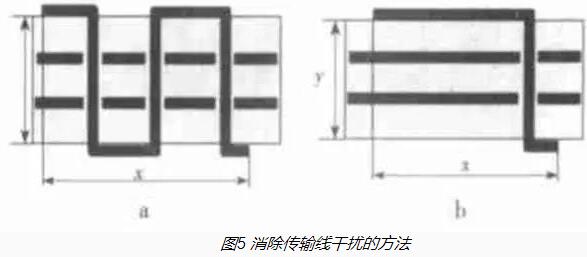
(B) Do not use stubs. Because any stub is a source of noise. If the stub line is short, it can be terminated at the end of the transmission line; if the stub line is long, the main transmission line will be used as the source, which will cause large reflections and complicate the problem, so it is not recommended to use it.
Three, coupling
1. Common impedance coupling: It is a common coupling channel, that is, the interference source and the interfered device often share certain conductors (such as loop power, bus, common ground, etc.), as shown in Figure 6.
Figure 6 Common impedance coupling
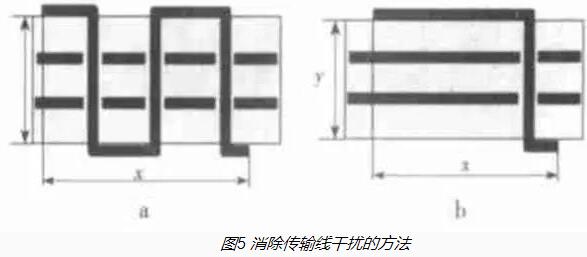
On this channel, the drop of Ic causes a common-mode voltage in the series current loop, which affects the receiver.
2. The field common mode coupling will cause the radiation source to cause common mode voltage on the loop formed by the interfered circuit and the common reference plane. If the magnetic field is dominant, the value of the common mode voltage generated in the series ground loop is Vcm=-(△B/△t)*area (△B=change in magnetic induction intensity). If it is an electromagnetic field, it is known When its electric field value, its induced voltage: Vcm=(L*h*F*E)/48, the formula is applicable to L(m)=150MHz or less, beyond this limit, the calculation of the maximum induced voltage can be simplified as: Vcm= 2*h*E.
3. Differential mode field coupling: refers to the direct radiation is induced and received by the wire pair or the lead on the circuit board and its loop. If it is as close as possible to the two wires. This coupling will be greatly reduced, so two wires can be twisted together to reduce interference.
4. Inter-line coupling (crosstalk) can make any line equal to undesirable coupling between parallel circuits, which will seriously damage the performance of the system. Its types can be divided into capacitive crosstalk and inductive crosstalk. The former is because the parasitic capacitance between the lines makes the noise on the noise source coupled to the noise receiving line through current injection; the latter can be thought of as the coupling of the signal between the primary and secondary stages of an undesirable parasitic transformer. The magnitude of inductive crosstalk depends on the proximity of the two loops and the size of the loop area, as well as the impedance of the load affected.
5. Coupling of power lines: refers to that after the AC or DC power lines are subjected to electromagnetic interference, the power lines transmit these interferences to other devices.
There are several ways to eliminate crosstalk in PCB design:
1. Both types of crosstalk increase with the increase of load impedance, so signal lines that are sensitive to interference caused by crosstalk should be properly terminated.
2. Increase the distance between signal lines as much as possible to effectively reduce capacitive crosstalk. Carry out ground layer management, space between wiring (for example, isolate active signal lines and ground lines, especially between signal lines that have transitioned states and ground) and reduce lead inductance.
3. Inserting a ground wire between adjacent signal wires can also effectively reduce capacitive crosstalk. This ground wire needs to be connected to the ground every 1/4 wavelength.
4. For inductive crosstalk, the loop area should be reduced as much as possible, and if allowed, this loop should be eliminated.
5. Avoid signal sharing loops.
6. Focus on signal integrity: The designer must implement termination during the welding process to solve signal integrity. Designers who adopt this method can focus on the microstrip length of the shielding copper foil in order to obtain good signal integrity performance. For systems that use dense connectors in the communication structure, the designer can use a PCB for termination.
4, electromagnetic interference
As the speed increases, EMI will become more and more serious and manifested in many aspects (such as electromagnetic interference at the interconnection). High-speed devices are particularly sensitive to this. Therefore, they will receive high-speed false signals, while low-speed The device will ignore such false signals.
There are several ways to eliminate electromagnetic interference in PCB design:
1. Reduce loops: Each loop is equivalent to an antenna, so we need to minimize the number of loops, the area of the loop and the antenna effect of the loop. Ensure that the signal has only one loop path at any two points, avoid artificial loops, and try to use the power layer.
2. Filtering: Filtering can be used to reduce EMI both on the power line and on the signal line. There are three methods: decoupling capacitors, EMI filters, and magnetic components. The EMI filter is shown in Figure 7.
Figure 7 Types of filters
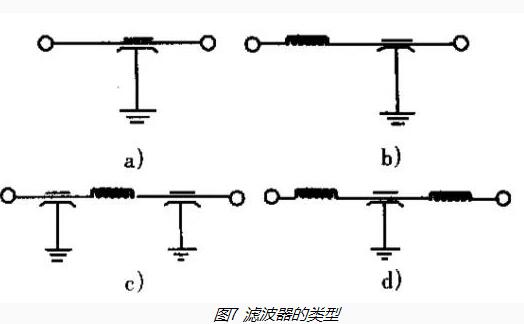
3. Shielding. Due to space issues and many articles discussing blocking, I will not introduce them in detail.
4. Try to reduce the speed of high-frequency devices.
5. Increasing the dielectric constant of the PCB board can prevent the high-frequency parts such as the transmission line close to the board from radiating outward; increasing the thickness of the PCB board and minimizing the thickness of the microstrip line can prevent the electromagnetic wire from overflowing, and it can also prevent radiation .
At this point of the discussion, we can conclude that in high-frequency PCB design, we should follow the following principles:
1. The unity and stability of power supply and ground.
2. Careful wiring and proper termination can eliminate reflections.
3. Careful wiring and proper termination can reduce capacitive and inductive crosstalk.
4. It is necessary to suppress noise to meet EMC requirements.